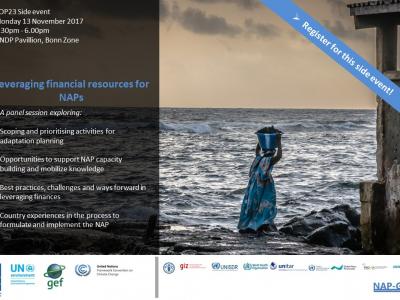Developing countries explore how to leverage financial resources for NAPs
Submitted by esther.lake@undp.org on 21 December 2017

13 November 2017, COP23, Bonn, Germany: On the sidelines of COP 23, the joint UNDP- UN Environment NAP-GSP held an event entitled ‘Leveraging financial resources for NAPs’. The panel session aimed to explore the scoping and prioritising activities for adaptation planning, as well as opportunities to support NAP capacity building through leveraging finances. Country experiences in the process to finance the formulation and implementation of the NAP were also featured.
Mr Mozaharul Alam, UN Environment, NAP-GSP opened the session as moderator. He provided a background on financing NAP formulation and implementation, considering the lessons learned from from COP16 and the Cancun Adaptation Framework, to the present.
He said, ‘We can consider the NAP as a planning exercise, and understand better how it can leverage financial resources. Sources of financing needs to be scaled up. It is useful to understand how NAPs can be used as a vehicle to reach out to multiple sources, and how to take strategic decisions about where investment is needed immediately.’
Ms Rohini Kohli, UNDP NAP-GSP, provided an introduction to NAP-GSP and the support provided by the programme. She emphasised the NAP as an instrument to safeguard development gains and enhance resilience.
She said, ‘Most Nationally Determined Contributions (NDCs) from developing countries include an adaptation component. Of these, most components emphasise the importance of assessment and detailed activity plans for medium-to-long term adaptation efforts. Adaptation planning should also consider SDGs and the implemention of the Sendai Framework.’
Ms Kohli gave some examples of NAP-GSP support to countries, as well as regional trainings and peer-to-peer exchange
Mr Dustin Schinn, the GEF, discussed the GEF’s support to adaptation planning, and highlighted the importance of leveraging finance, and using NAP as an instrument.
He said, ‘The NAP-GSP is important to GEF, as a first stepping stone to help countries assess their needs to advance the NAP process. The NAP-GSP provides catalytic support that countries can use.’
The GEF has also supported projects to help countries advance their NAP process, and receives requests from countries on joint NAP-NAPA projects, especially for such activities such as climate information services. The GEF responds to countries´ needs, based on their priorities, and invests around USD 51 million in NAP-related projects, mainly in LDCs.
Country experiences in leveraging finance for NAPs
Experiences in mobilizing financial resources for adaptation planning were heard from Tonga and Senegal.
Ms Luisa Tuiafitu-Malolo, Tonga, gave an outline of Tonga’s experience with the revision of the Joint National Adaptation Plan (JNAP). Tonga was the first country in the Pacific to formulate this joint initiative. The JNAP was endorsed by the Cabinet in 2010, and formed a milestone of the Tonga 2nd National Communication. Tonga mobilized funding from various development partners, including the governments of Germany, EU and Australia.
In summary, Ms Tuiafitu-Malolo said, ‘Tonga recognizes the Importance of having a plan in place and a champion agency to drive implementation. It is also important to have a good coordination mechanism.'
Mme Madeleine Rose Diouf Sarr presented on Senegal’s experience with leveraging support from multiple partners for the NAP. Senegal has identified the following vulnerable sectors: water, agriculture, coastal zones, infrastructure, health, and tourism (linked to coastal zone), and has identified three types of funding available for the NAP. The NAP process was commenced with support from USAID for the fishery sector – which has developed an official NAP document and is now looking towards implementation. Senegal is also received LDCF funding. In addition, Senegal has USD 3 million from GCF, and support from GIZ.The NDC has a strong adaptation component. The country seeks to have complementarity between different financing sources, and has established one joint steering committee.
Jason Spensley, GCF, presented on GCF’s good practices on adaptation planning, outlining how the GCF is advancing NAP formulation and implementation.
He said, ‘It is important to keep in mind that producing a NAP is not an end in itself. What we need is action and we should be seeking more funding for action. Adaptation needs much more than the USD 3 million offered by GCF readiness. But this provides a golden opportunity to plan adaptation well.'
He explained how most of the investment will eventually come from the private sector, and explored the process for working with individual corporations (including the tourism industry, large scale agro-forestry programmes, systems and schemes, and the transport sector.
The session closed with questions to the panel from the participants, covering challenges to accessing finance, linking the NDC to NAPs, and best practices in adaptation planning.